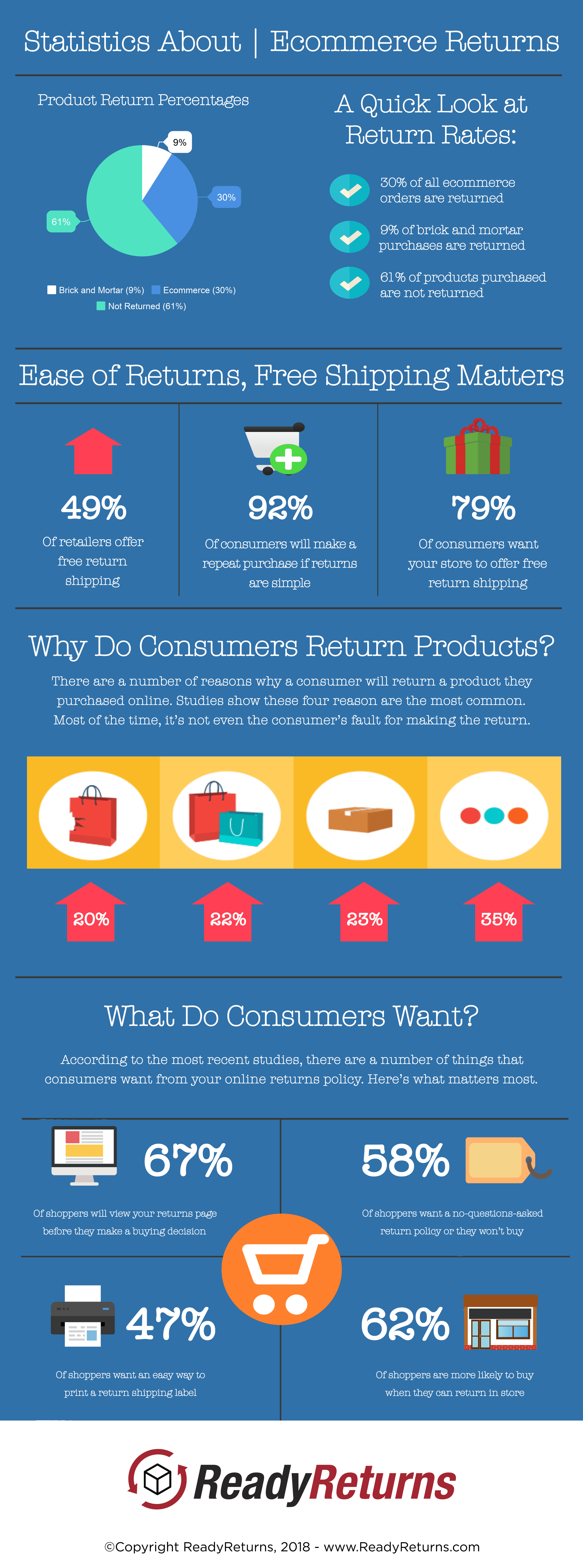2018 Broke All Records for Online Product Returns in Ecommerce

As shoppers opened up their wallets to drop record amounts of money on holiday shopping this past year, with Cyber Monday doing $7.9 billion in sales alone, buyer’s remorse was unavoidable. This was especially true in the apparel sector, where returns peaked at about 50%.
Did 2018 really break all ecommerce return records to date?
Here’s what you need to know.
“A great e-commerce experience requires more than competitive prices, a robust selection of goods, fast shipping and easy returns … it takes them all. Today’s consumer mindset has changed. Services like Amazon Prime have set the bar at a higher level, with speedy delivery, low prices, a vast selection and hassle-free returns.”
What We Learned from 2018
The highs and lows of last year’s ecommerce season give us a better understanding of consumer buying and returning habits in 2018. By and far, the numbers told us that consumers expected returns to be as easy as buying online or they’d take their business elsewhere. What can we learn from last year’s ecommerce return statistics?
Here are some solid takeaways to add to your checklist:
- 80% of shoppers wanted hassle-free returns.
- Returns were the merchant’s fault 66% of the time.
- 66% of customers read a return policy before buying.
- Just 11.8% of retailers offered free return shipping.
- 81% of customers wanted free return shipping.
- 50% of shoppers thought that returns should have been easier to make online.
- 42% of shoppers weren’t satisfied with the process of making an online return.
- 68% of shoppers viewed free return shipping as a positive shopping experience.
- 86% of shoppers wanted a return shipping label provided by an e-retailer.
- 63% of shoppers were unhappy when they paid return shipping fees.
- 52% of shoppers wanted the return shipping label included in the box.
- 51% of shoppers wouldn’t make a purchase if the return shipping label wasn’t in the box.
Clothing Returns Topped the List
As Retail Dive reports, half of apparel purchased online over the holiday shopping rush was likely to be returned by consumers.
Why does clothing have such a high return rate? Because buyers are unable to try it on before they buy it. Even with sizing apps in place and other methods of helping shoppers know it’s a fit before they click the “checkout” button, apparel return rates in 2017 ranged from 30%-40% in ecommerce, topping the list of most commonly returned ecommerce purchase.
“Return problems are getting worse because more and more business is moving online, where consumers cannot try on clothing to evaluate fit prior to purchase. This makes for an error prone relationship with respect to apparel fit,” BodyBlock AI CEO and Co-Founder Greg Moore explained to Retail Dive in an email interview.
Consumers Have Spoken
As the retail industry increasingly shifts its focus to online sales and fast, convenient delivery, consumers expect more from the brands they trust. Free shipping has become the standard for retailers hoping to compete for their slice of the ecommerce pie. On the flipside, consumers also expect that returns should be fast, easy and free, too.
“Consumers now expect delivery to be fast, reliable and free. Click and collect has become a prerequisite and shoppers have come to expect free returns. The customer has never had it so good – but this has added a lot of cost and complexity for retailers,” Natalie Berg, Founder, NBK Retail, commented to Retail Dive in a recent interview.
With years of aggregate data to cull, think tanks have determined that a retailer’s ecommerce return policy can influence the buying decision by as much as 80%. As the numbers break down, consumers are 82% likelier to close the sale when hassle-free, no-questions-asked returns are offered with no restocking fees.
Factoring in the Holiday Rush
Returns are even higher during the holiday shopping rush because so many more purchases are made, many at the spur of the moment, and many that are financed by consumers. As we’ve mentioned above, these two reasons can increase return rates substantially and both factor into the 22% of returns caused by buyer’s remorse specifically.
Here’s a breakdown of the average holiday ecommerce return rate by category:
- Hard goods, gifts – 1%-5%
- Home décor – 5%-9%
- Shoes – 10%-25%
- Casual apparel – 10%-20%
- Electronics/computers -15%-20%
- Fitted apparel – 20%-30%
- High fashion – 25%-40%
As you can see, apparel has the highest return rate, while hard goods have the lowest. Everything else falls roughly in the middle of the road, as far as percentages are concerned. Interestingly, cart abandonment rates drop slightly during the holidays but are offset by increased return rates. And so, the great ecommerce balancing act continues to factor in.
Taking a Bite Out of Bad Returns
One thing to keep in mind is that bad returns don’t mean fewer returns; they just mean fewer repeat purchases and reduced retention. While some big box retailers like Apple can get away with a rotten return policy, the reality is that most cannot afford to overlook the benefits of offering a hassle-free return policy.
The truth is that consumers view your return policy differently than you may suspect:
“There’s been a notable change in attitudes on returns,” explained Chris Dunn, CEO of ReadyCloud CRM in an interview with Wall Street Journal. “In year’s past, retailers weren’t all that receptive (to a hassle-free return policy). They were thinking that by not offering easy returns, people would not return their purchases. They’re starting to realize that you’re still going to return, and you’re not going to buy from that retailer again.”
What can you do to improve your return policy and get more sales? Here are 10 Ways to Improve Your Return policy right now.
Need Even More Info?
We’ve got you covered in this helpful infographic on ecommerce product returns statistics. Feel free to repost it to your own blog or to share it on social media as you see fit. Also, make sure you check out: The Ultimate Guide to Ecommerce Returns, it can help you position your return policy to improve sales, loyalty and retention.

What You Should Do Now
Here are 3 ways ReadyReturns can help you deliver amazing return experiences that eliminate prepaid labels and boxes, delight customers, and protect your margins:
Schedule a Demo – See how ReadyReturns turns product returns into your competitive advantage with “Amazon-like” returns and cost-saving features.
Start Your Free Trial of ReadyReturns (No CC Required) – Set up in minutes. Instantly offer QR code returns, product exchanges, and custom return rules that turn frustrated customers into repeat buyers.
Try ReadyCloud at No Cost – Why manage shipping and returns separately? Get ReadyShipper X, ReadyReturns, and more in one unified platform for seamless fulfillment and order management.
Share On:









